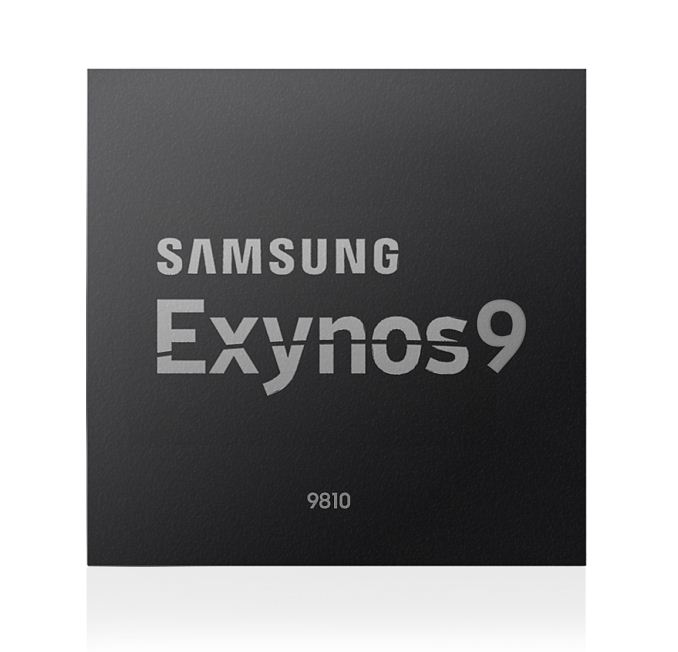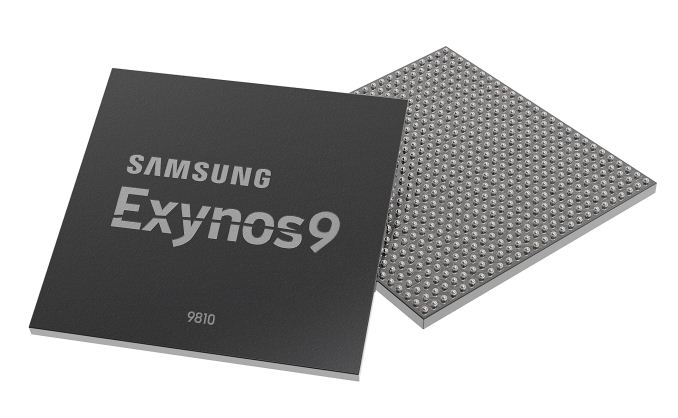Samsung Announces New 9810 SoC: DynamiQ & 3rd Gen CPU
by Brett Howse & Andrei Frumusanu on January 3, 2018 10:30 PM EST- Posted in
- Mobile
- Samsung
- Smartphones
- SoCs
- S.LSI
- Exynos 9810

After teasing the Exynos 9810 in CES related press material back in early November as well as having early announcement about the new modem capabilities last summer we now finally see the official announcement of the new SoC ahead of CES next week.
The new Exynos 9810 much like the Snapdragon 845 announced a few weeks ago in December, is a major upgrade on the CPU side of things as we do the migration towards a DynamiQ cluster configuration. Here we find Samsung’s third-generation custom core, the Exynos M3. We don’t know much about the micro-architectural changes of the new core, however Samsung has stated that the new CPU has a wider pipeline, and improved cache memory. What we expect is a large overhaul of the memory subsystem in the private L2 cache, as well as a larger L3 which will bring major performance uplifts in memory access during heavy workloads. Coupled with the M3 cores we see ARM’s new A55 little cores used as the efficiency cluster.
| Samsung Exynos SoCs Specifications | |||
| SoC | Exynos 9810 | Exynos 8895 | |
| CPU | 4x Exynos M3 @ 2.9 GHz 4x 512KB L2 ?? 4x Cortex A55 @ 1.9 GHz 4x 128KB L2 4096KB L3 DSU ?? |
4x Exynos M2 @ 2.314 GHz 2048KB L2 4x Cortex A53 @ 1.690GHz 512KB L2 |
|
| GPU | Mali G72MP18 | Mali G71MP20 @ 546MHz |
|
| Memory Controller |
4x 16-bit CH LPDDR4x @ 1794MHz |
4x 16-bit CH LPDDR4x @ 1794MHz 28.7GB/s B/W |
|
| Media | 10bit 4K120 encode & decode H.265/HEVC, H.264, VP9 |
4K120 encode & decode H.265/HEVC, H.264, VP9 |
|
| Modem | Shannon Integrated LTE (Category 18/13) DL = 1200 Mbps 6x20MHz CA, 256-QAM UL = 200 Mbps 2x20MHz CA, 256-QAM |
Shannon 355 Integrated LTE (Category 16/13) DL = 1050 Mbps 5x20MHz CA, 256-QAM UL = 150 Mbps 2x20MHz CA, 64-QAM |
|
| ISP | Rear: 24MP Front: 24MP Dual: 16MP+16MP |
Rear: 28MP Front: 28MP |
|
| Mfc. Process |
Samsung 10nm LPP |
Samsung 10nm LPE |
|
Samsung hasn't announced all of the new CPU parameters yet, but they have announced a 2.9 GHz maximum frequency for the M3 cluster, which is a large step up over the 2.3 GHz of the outgoing model. This is thanks to the Exynos 9810 being produced on the second generation 10nm manufacturing node, 10LPP, which promises up to 10% performance increases at isi-power or a 15% decrease in power at iso-performance.
With the increased IPC that is expected from the new cores, and the faster frequency, this should be a significant increase in performance from the outgoing model, which we saw in our comparison test was fairly evenly matched with the Qualcomm Snapdragon 835. Samsung claims up to double the single-thread performance and 40% uplift in multi-thread performance. The single-thread performance claim would be the single biggest performance jump in the industry and if we're even just talking simple GeekBench scores that would put the Exynos 9810 at the performance levels of Apple's A10 and A11. Of course having this on a quad-core CPU begs the question of how it's achieved and if this 2.9GHz clock is on all cores or just a single-core boost clock? And at what kind of TDP does it achieve this massive performance boost?
The GPU follows the lead of the Kirin 970 in adopting the new Mali G72 Heimdall GPU IP from ARM. What stands out here is that Samsung has actually decreased the GPU core count from 20 to 18 while still managing to increase performance through an increase of the clock frequency from 546MHz to a higher undisclosed frequency likely in the mid 700MHz range. The performance increase is conservative at only 20%, but more importantly efficiency should be up thanks to the new GPU and process.
The modem as disclosed earlier in 2017 now adheres to 3GPP Release 13 and implements UE Category 18 up to 1200Mbps in its downlink capabilities through up to 6xCA and 256-QAM, slightly exceeding the capabilities of the Snapdragon 845 and Kirin 970 on paper, but likely something to be tested in practice. The Exynos 9810 modem also is the first one to employ 256-QAM in the uplink and thus achieving up to 200Mbps speeds as a UE Category 18 in the uplink as well.
As is usual with new flagship Exynos announcements the SoC is likely already in mass production and waiting to be used in the new Galaxy S9 series which in turn will be expected in the MWC timeframe at the end of February.
Source: Samsung Newsroom












43 Comments
View All Comments
Phylyp - Wednesday, January 3, 2018 - link
Coming on the heels of the Apple SoC throttling news, I wonder how these high-performance cores clocked at 2.9 GHz (up from 2.3 GHz) will perform once the batteries age, especially since it is still Samsung's 10 nm process with a small improvement.Samsung was quick to announce they don't throttle SoCs on old batteries, but that doesn't take away from the fact that Apple's solution was technically very sensible (they made a mess out of communications though).
Phylyp - Wednesday, January 3, 2018 - link
As in - 10 nm LPP offers 10% performance increase over 10 nm LPE, but the clocks have gone up by more than 0.23 GHz.Zeratul56 - Wednesday, January 3, 2018 - link
I do wonder what the industry wide effect of old batteries are, many were quick to demonize Apple on this but I feel like something that was related to the basic nature of batteries couldn’t be completely limited. I know two things affected Apple that don’t affect most, Apple maintaining smaller than average batteries over most smart phones(especially the 4.7” variant) and the iPhone 6s which seemed to be hit har by this(some flaw in the Soc?)With all that said, I don’t think other phones are not affect. Especially when considering things like clock speed which are generally higher year to rear on android.
I wish we could get an in-depth analysis on the battery issue from a anandtech butvthat might be too much to hope for.
Jhlot - Friday, January 5, 2018 - link
I recall when my Samsung S3 got around the 2 year mark I definitely noticed a loss in battery time and then it started to randomly shut off between 10-20% batter left which was very frustrating. I assume this occurred because the aging battery couldn't maintain the voltage or current when I fired up something that took more resources. So limiting the processor to stop random shutoffs from an old battery not being able to keep up is interesting and might be a fair trade for more predictable battery life because random shut down when you think you have 10-20% left sucks if you were relying on it.lilmoe - Thursday, January 4, 2018 - link
Samsung's Exynos doesn't have the efficiency problems that Apple's SoCs have had for years, the problems everyone refuses to write about. The only "blunder" I can think of was the 5410, and that was ARM's fault with the CCI400. Neither do Qualcomm's recent snapdragons nor the recent 2 Kirins after ARM fixed their interconnect and post the a57. They're much more sophisticated than what Apple is doing.Keep in mind that these chips are ruining much heavier, open software on much higher resulting screens for apparently more time than Apple's.
No, Apple's solution is in no way sensible as you'd hope. There is nothing extraordinary about core CPU architecture nowadays, since we know pretty much everything there is to know about their design and the behavior is silicon. If you have the time and money, you can build whatever core you want.
What matters more is what you do with what you got, and how much it can support, AND how much you can offload in the most efficient way and with least overhead.
If you need to drop the clocks you well below half to prevent huge power consumption spikes, then you have one serious issue with your core architecture and/or platform as a whole. Apple knows this, hence the gradual move to the little cluster the past 2 iterations.
This, mind you, is giving Apple the benefit of the doubt, since lithium batteries are a pretty damn known quantity at this point, and an oem knows before hand how big of a battery needs to be fitted to support a platform's longevity. If you still believe that Apple's SoCs have no problems, then that's even worse. Apple is either intentionally under-engineering the power delivery in their products as to not last and perform as advertised for more than 1-2 years, or they're intentionally slowing down their devices via software. Either way they're getting what they deserve over this.
It's Apple's job to do the apology and fix, not yours.
Alistair - Thursday, January 4, 2018 - link
You wrote too much. They have no SoC problem, just a battery current draw problem (can be fixed with better batteries, or larger ones.lilmoe - Thursday, January 4, 2018 - link
They do. You guys need to stop trying to cover for Apple. Underclocking to 600mhz is a problem with the SoC.And yes, they also have problem with small batteries and power delivery.
StormyParis - Thursday, January 4, 2018 - link
Apple (and most others, but Apple certainly was at the forefront of "courage" on that one too) have a battery problem because of a cascade of unforced errors:1- make the batteries small to start with (nevermind it's a known fact they'll get even smaller with use)
2- make the batteries non-removable
3- make the batteries not user-replaceable
4- sell battery swaps ($3 battery, 5 minutes of work) for $80. Even at $30, they're making a killing, thank you.
5- throttle old batteries, but don't give uses a choice nor a warning
Spunjji - Thursday, January 4, 2018 - link
Transient current draw is directly linked to the SoC and thus its design. You literally invalidated your own argument.philehidiot - Thursday, January 4, 2018 - link
Surely this is just an overall design issue, not just an SoC issue or battery issue. When designing a device like this you calculate the overall peak current draw you can take from the battery and then you budget that to different components. Other manufacturers have clearly taken the budget from what the battery can provide after a couple of years of life. Apple have taken a decision to allow better performance at the beginning of life knowing that this is not sustainable. I would argue this is misrepresenting the product as it will perform differently in stores and for reviewers than it will for the reasonable life of the product.